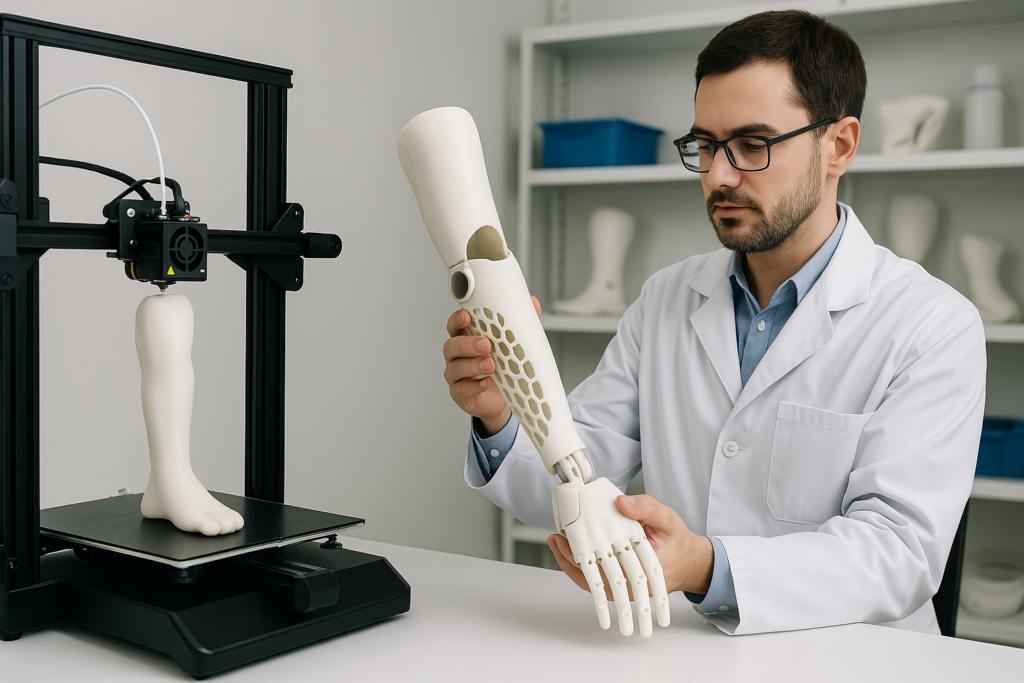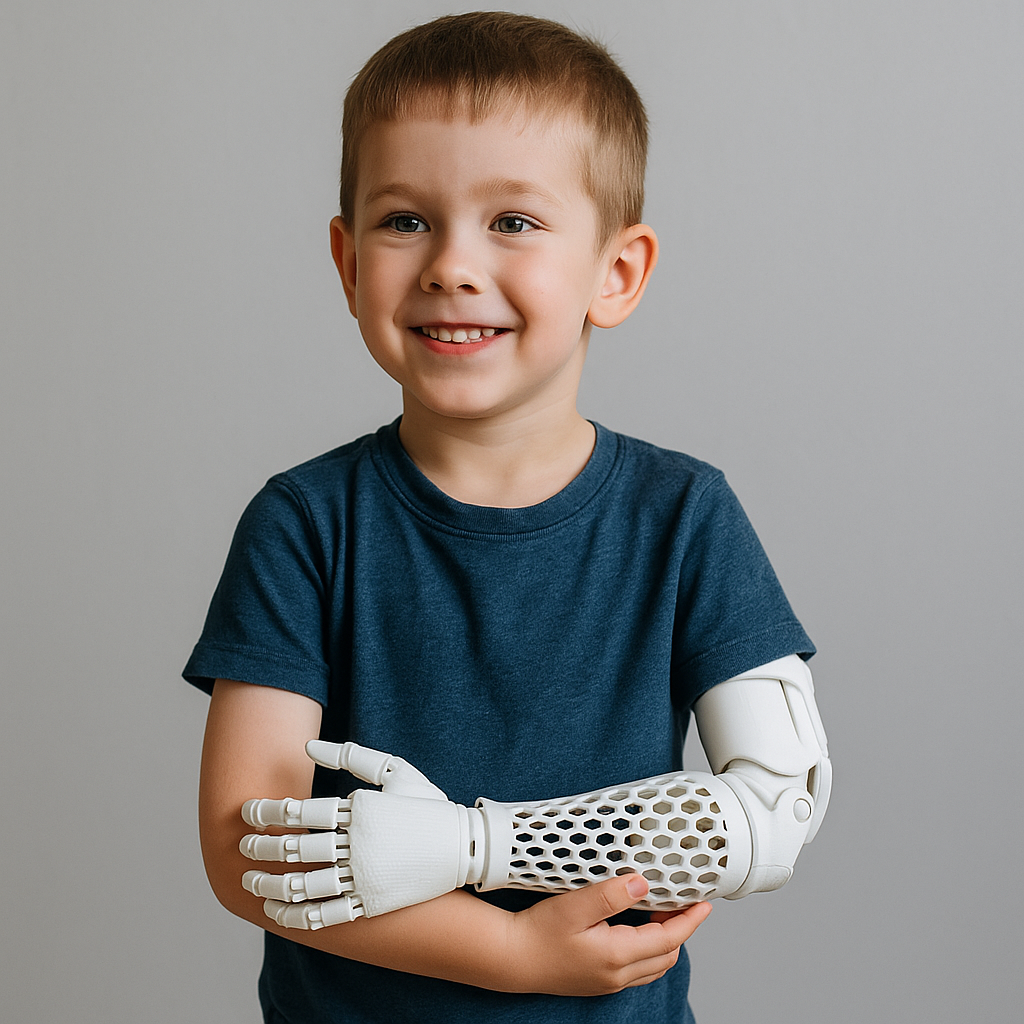Imagine losing a limb and being told that the replacement could take months and cost a fortune. Now, picture getting a fully customized prosthetic limb in just a few days at a fraction of the cost. This isn’t a scene from a sci-fi movie — it’s the power of the 3D printing industry at work.
The fusion of 3D printing and prosthetics is changing lives across the globe. With improved accessibility, speed, and personalization, this technology is bridging the gap between affordability and innovation. In this post, we’ll explore how 3D printing is reshaping prosthetics, the risks it brings, future possibilities, and global approaches to ethical regulation.

Benefits of 3D Printing in Prosthetics
1. Cost-Effective Solutions
Traditional prosthetics can cost between $5,000 and $50,000. With 3D printing, the cost can drop below $500 without compromising quality.
Key takeaway: Affordable and accessible prosthetics are now a reality for many.
2. Customization and Comfort
3D printing allows for the creation of bespoke prosthetics tailored to a patient’s exact measurements, ensuring a better fit and enhanced usability.
- Tailored socket designs for individual anatomy
- Adjustable grip mechanisms for hand prosthetics
- Lightweight materials for better mobility
3. Rapid Prototyping and Production
What once took weeks or months now takes hours or days. 3D printing accelerates the entire design-to-delivery process.
Example: Organizations like e-NABLE and Limbitless Solutions create functional arms for children within days.
4. Empowerment Through Local Production
Local clinics can produce prosthetics on-site using open-source designs. This is especially impactful in underserved regions with limited access to advanced medical equipment.
5. Adaptability for Children
Children outgrow prosthetics quickly. 3D printing enables frequent, low-cost adjustments and replacements.

How 3D Printing in Prosthetics Works (Simplified)
The process begins with 3D scanning of the patient’s residual limb, followed by digital modeling using CAD software. The final design is then printed using materials like PLA, ABS, or medical-grade TPU using additive manufacturing.
Technical terms simplified:
- Additive manufacturing: Building objects layer by layer
- CAD (Computer-Aided Design): Software used to design parts
- PLA/ABS/TPU: Types of plastic used in printing
This streamlined workflow reduces human error and enables faster iterations.
Risks and Ethical Concerns
1. Quality and Safety Regulation
Without strict standards, there’s a risk of prosthetics failing or causing harm. Not all printed devices undergo rigorous testing.
Case Study: In 2021, a community-driven prosthetic failed during use due to incorrect material selection and inadequate testing protocols.
2. Intellectual Property Issues
Open-source designs fuel innovation, but raise concerns about copyright infringement and the unauthorized duplication of patented models.
3. Bias and Accessibility
Designs from certain regions may not consider diverse body types, climates, or lifestyles, potentially excluding some users.
4. Environmental Concerns
While some printing materials are recyclable, many are not biodegradable, contributing to plastic waste.
5. Lack of Informed Consent
Users may not fully understand the limitations or risks of 3D-printed devices, especially in regions lacking health literacy.
Ethical takeaway: Innovation must not outpace regulation and awareness.
Future Applications and Innovations
1. Smart Prosthetics
Researchers are combining 3D printing with AI and sensors to create bionic limbs that mimic natural movement and provide feedback to the user.
Example: Bionic arms controlled via EMG signals from muscle activity.
2. Bio-Printed Tissues
The same technology is being explored for printing skin, cartilage, and even bone — offering new possibilities in regenerative medicine.
3. Remote Diagnosis and Telehealth Integration
3D-printed prosthetics can be designed remotely and shipped or printed locally, reducing dependence on centralized healthcare facilities.
4. Modular and Interchangeable Parts
Future designs may allow users to swap parts based on activity (e.g., typing, sports, or cooking).
Global Solutions and Regulation
1. International Standards
Efforts are underway to create global certification standards for 3D-printed medical devices. ISO and WHO are collaborating to issue guidelines.
2. Data Protection Laws
Digital limb models and patient data must be protected under regulations like:
- GDPR (Europe)
- DPDP Act (India)
- HIPAA (USA)
3. Collaborative Ecosystems
NGOs, startups, universities, and local governments are forming networks to share best practices, resources, and regulatory compliance tools.
FAQs
Q1: How long does it take to 3D print a prosthetic limb?
A: Depending on complexity, a basic prosthetic can be printed in 8–24 hours, with additional time for assembly and testing.
Q2: Is 3D-printed prosthetics safe for long-term use?
A: Yes, when produced using certified materials and approved processes. Always consult medical professionals.
Q3: Can children use 3D-printed prosthetics?
A: Absolutely. Many designs are specifically made for growing children and are adjustable or replaceable.
Q4: What are the main materials used in 3D-printed prosthetics?
A: PLA, ABS, TPU, and medical-grade silicone are common due to their durability and safety.
Q5: Do 3D-printed prosthetics work as well as traditional ones?
A: In many cases, yes — especially for low-impact activities. Advanced prosthetics for complex tasks are also evolving.
Conclusion
3D printing is rewriting the rules of what’s possible in prosthetics — making life-changing technology more inclusive, personalized, and affordable. The road ahead demands thoughtful regulation, deeper collaboration, and a focus on ethical, user-first innovation.
What are your thoughts on the future of 3D-printed prosthetics? Share your insights in the comments below!
references:
- Global data and insights on access to assistive devices and innovation in prosthetics.
- In-depth medical research on 3D-printed prosthetics and their safety and functionality.
- Global perspective on the digital revolution, including 3D printing in healthcare applications.
Ready to Stay Ahead? Bookmark our guide Technology and AI for updates!


